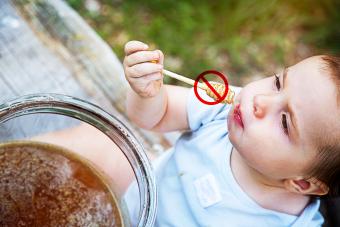
Bottle feeding your baby is more than just supplying your baby with nutrients, it is a prime time to bond with your baby. There are many types of formula that give your baby a healthy start in life, however, for new parents, bottle feeding can be a bit overwhelming until you and your baby establish a routine.
In the Hospital
For babies who will be bottle fed, the nursing staff will supply the formula. Sometimes, they may even feed the baby, if the mother can't for some reason. In addition, you can expect staff to take the time to give some one-on-one instruction for mixing the formula and feeding your baby. Typically, the hospital doesn't have a huge selection of formula, so if you are set on a certain brand or type, be sure you bring some with you when you go into labor.
Establishing a Schedule
Once you take your baby home, you're on your own. You and your partner will spend a lot of time bottle feeding your baby, especially for the first few months. Several years ago, pediatricians encouraged parents to feed on a set schedule, usually every three to four hours.
Today, doctors realize that different babies have different needs. The general rule is to feed on demand, according to the experts at Baby Center. You'll soon realize when your baby is hungry, and you should feed her accordingly. In the first few weeks, this will probably be every two to three hours, but as she grows and develops, you'll begin to notice a pattern to her eating. Don't force your little one to eat just because it's been a few hours since her last feeding. This creates a pattern that can be hard to break as she gets older.
At this time, you can begin establishing some semblance of a feeding schedule. For questions and concerns about bottle feeding your baby, contact your pediatrician.
How Much Formula to Feed
Babies are all different and therefore have different appetites. Resist comparing your baby to your best friend's baby or even your older child. However, there are some general guidelines regarding how much formula to feed your baby. Using these can help you ensure that your little one is getting enough to eat on a daily basis. As your baby grows, he'll naturally eat more so follow his lead. Don't worry if he doesn't always finish the bottle or if he wants more. Just be sure he's full and happy. Use the following measurements from Kids Health as your guide:
- Newborns need one and a half to three ounces of formula every couple of hours.
- Between 2 to 4 months, your baby will likely eat 4 to 5 ounces of formula, every two to four hours.
- From 4 to 6 months, your baby will probably eat 4 to 6 ounces every few hours.
- Beyond 6 months, your baby's needs will increase to 6 to 8 ounces every 4 to 5 hours.
Many moms find that keeping a feeding chart helps them begin to detect a pattern in their baby's eating habits so they can begin to know when their little one will be ready for another meal. If you're ever concerned about how much your baby is eating, talk to his pediatrician.
Sterilizing Bottles
Sterilizing bottles reduces the risk that contaminated water will make its way into your baby's body. Fortunately, it's very easy to do. The American Academy of Pediatrics instructs parents to wash their hands thoroughly, then wash the bottles and nipples with hot soapy water and rinse them very well with more hot water. You can also boil bottles and nipples for five minutes or run them through the sterilizing cycle of your dishwasher. At the same time, it's important to use safe water for preparing formula. The AAP suggests using bottled water, but you can also boil water for at least one minute, then cool and use to mix formula in a bottle.
Types of Formula
Bottle feeding your baby involves not only cleaning the bottles, nipples, and any other bottle accessories, but also preparing the formula. Formula generally comes in three styles, according to the National Institutes of Health:
- Powder: This is by far the cheapest formula. You can buy large cans of formula, which you will then mix with water or breast milk according to the directions on the can.
- Liquid concentrate: You generally have to mix liquid concentrate with water before use.
- Ready-to-use: This formula is just what it implies. It's ready to use straight out of the can. It is very convenient, great for travel, but also more expensive.
Your pediatrician will typically recommend a formula for your baby. If you notice any problems, however, you should notify him or her immediately before switching formulas.
Ingredients in Formula
Much like there are different types of formula textures, there are several formulas with a variety of ingredients that ensure you'll get just the right type for your baby. Generally, cow's milk formula is the most common, but there are many types that cater to babies with food allergies, intolerances and other health issues. The following are the easiest types to find:
- Cow's milk - This formula is created to simulate breast milk as closely as possible and is the most common type of formula on store shelves. For most babies, this type of formula is easy to digest and provides them with the nutrients they need to grow and develop.
- Soy formula - This is an ideal choice for babies who have trouble digesting cow's milk. Some parents choose it to keep animal proteins out of their little one's diet.
- Hydrolyzed formula - This type of formula is generally more expensive and is typically recommended for babies who have trouble digesting cow's milk or soy milk formulas.
Other special formulas include lactose-free versions and those made for infants with special health conditions, such as reflux, heart disease or malabsorption issues.
You might also find that the right formula for your baby changes as he grows. Be sure to talk to your baby's pediatrician before making a switch.
Warming the Bottle
You should never heat a bottle in the microwave, say the experts at Parents magazine. Instead, set the bottle in a cup or pan of warm water, or hold it under running water to warm.
It should be noted too, that babies don't have to have heated bottles, but sometimes they prefer warm rather than cold formula or breast milk.
How to Bottle Feed Your Baby
Finally, whether you feed your baby breast milk or formula, bottle feeding your baby should be a bonding time for you both. For new and inexperienced parents, finding the best position for feeding your baby will take some time. Holding your baby at a 45-degree angle should reduce her chances of taking in excess air. Be sure that the nipple is always full of fluid as well.
Hold her close, look into her eyes, and enjoy this quiet time together. In a very short time, your baby will have grown into a toddler, and your quiet moments with her will be few and far between.







